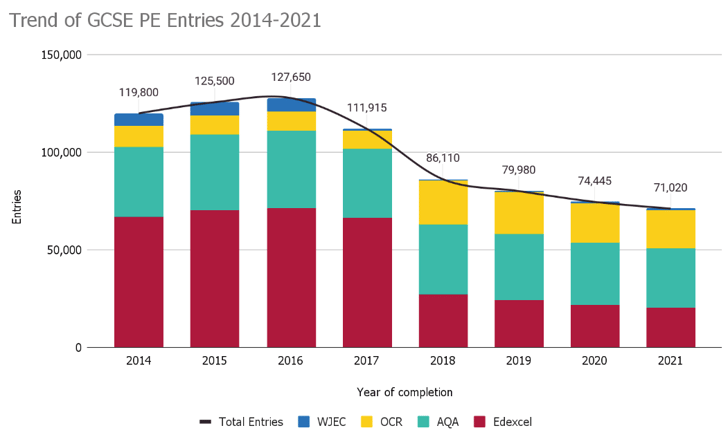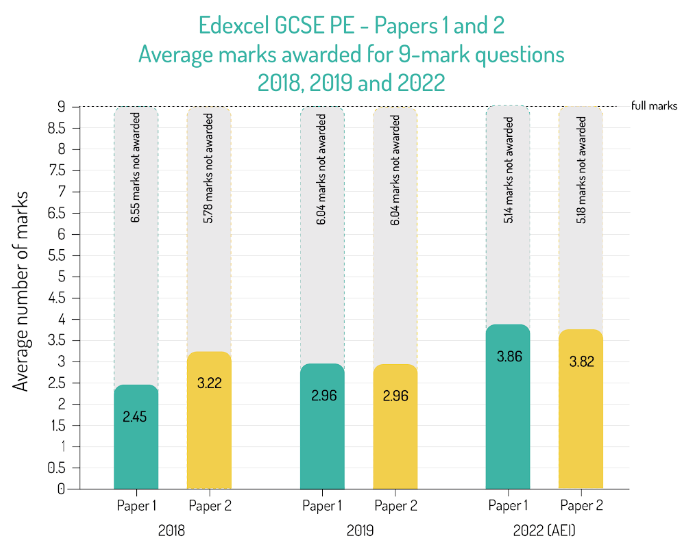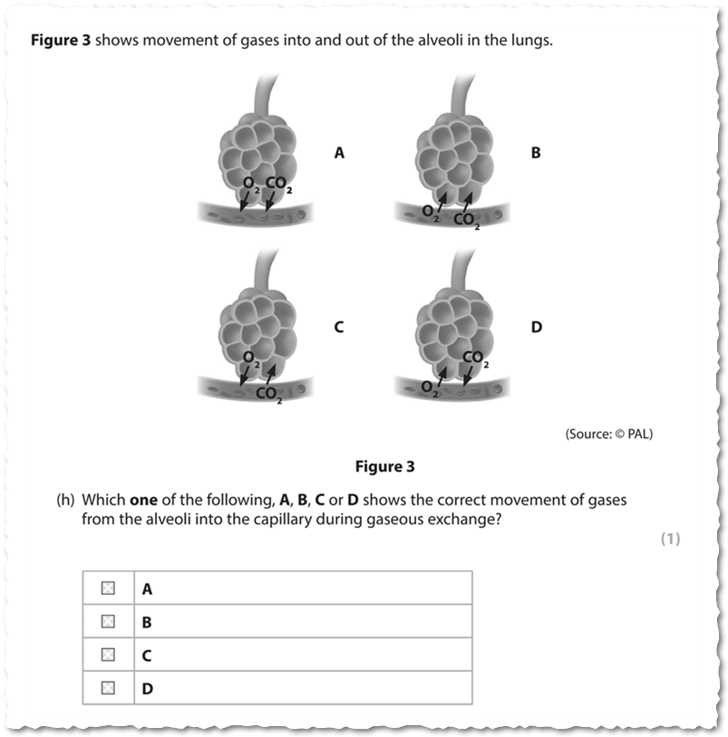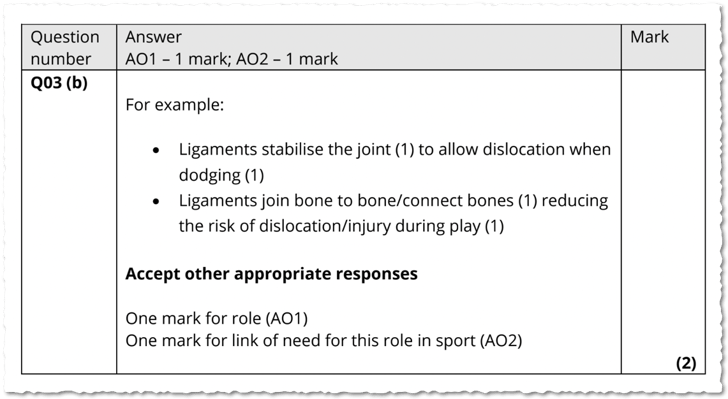Changes to Edexcel GCSE PE Exams - Will this arrest the slump?
On 17th June 2022, Edexcel/Pearson published their changes to their qualifications for first assessment in 2023. This means that current Year 11 students will be sitting exams that are structured differently to those sat by Year 11s in summer 2022.
Why are these changes occurring?
According to Edexcel/Pearson, the changes are being made in the following context:
"GCSE PE - Changes to qualifications for first assessment 2023"
So, Edexcel/Pearson are suggesting that these changes are simply representative of good practice and the ongoing need to make changes based on feedback. This is highly laudable and Edexcel/Pearson are thanked for this approach.
Those of us that want the full picture will also assume that Edexcel/Pearson are making changes due to commercial pressures. I hold this view. The reality is that Edexcel/Pearson GCSE PE has been declining in student numbers for a sustained period of time:

One of the factors causing this has been the dissatisfaction that colleagues are feeling about the extended writing requirements of the two exam papers.

Nine-mark questions on all Edexcel papers have involved students not achieving most of the marks available on average. Even in 2022, with advanced exam information available, most of the marks available were not achieved and this has led, presumably along with lots of feedback from centres, to one nine-marker per paper being removed and to the identification of the range of material from which the nine-marker can be drawn.
So, these appear to be the issues. So what has Edxcel done?
What are the changes to the exams?
Edexcel/Pearson are looking to make their GCSE course more competitive in the market. This is what they have done:
Changes to Exam Paper 1
|
Edexcel was: |
Edexcel is now: |
AQA is: |
OCR is: |
|
105 mins |
90 mins |
75 mins |
60 mins |
|
90 marks |
80 marks |
78 marks |
60 marks |
|
0.86 marks per minute |
0.89 marks per minute |
1.04 marks per minute |
1.00 marks per minute |
|
2 x 9-mark extended writing answers |
1 x 9-mark extended writing answers |
1 x 6 and 1 x 9 mark extended writing answers |
1 x 6 mark extended writing answer |
|
20% of marks from extended writing |
11.25% of marks from extended writing |
19.23% of marks from extended writing |
10% of marks from extended writing |
Edexcel have also stated that Paper 1 will now be split into three specific sections:
|
Section A |
Section B |
Section C |
|
Anatomy and Physiology and Movement Analysis |
Physical Training |
One extended response on physical training |
Section C of Paper 1 (containing the nine-mark question) will only be taken from the Physical Training part of the content (examined in section B). This will provide centres with the opportunity to focus their practice on this area of the course only.
Changes to Paper 2
|
Edexcel was: |
Edexcel is now: |
AQA is: |
OCR is: |
| 75 mins | 75 mins | 75 mins | 60 mins |
| 70 marks | 60 marks | 78 marks | 60 marks |
| 0.93 marks per minute | 0.8 marks per minute | 1.04 marks per minute | 1.00 marks per minute |
| 2 x 9-mark extended writing answers. | 1 x 9-mark extended writing answers | 1 x 6 and 1 x 9 mark extended writing answers | 1 x 6 mark extended writing answer |
| 25.7% of marks from extended writing | 15% of marks from extended writing | 19.23% of marks from extended writing | 10% of marks from extended writing |
Edexcel have also stated that Paper 2 will now be split into three specific sections:
|
Section A |
Section B |
Section C |
|
Health, Fitness and Wellbeing |
Sport Psychology and Sociocultural Influences |
One extended response from section B on Sport Psychology and Sociocultural Influences |
Section C of Paper 2 (containing the nine-mark question) will only be taken from the Sport Psychology and Sociocultural Influences part of the content (examined in section B). This will provide centres with the opportunity to focus their practice on this area of the course only. It is not currently clear whether the nine-mark question may cover content from both Sport Psychology and from Sociocultural Influences within the same question.
What’s my opinion on the changes to Edexcel exams?
The first observation to make is that Edexcel is aiming to position their course far closer to that of OCR GCSE PE. Paper 2 in particular reads as relatively similar. OCR have done well since 2016 and have grown their cohort size during the period that Edexcel has been declining. But, despite the statistical similarities, there are major differences between Edexcel and OCR for GCSE PE theory exams:
- OCR has a narrower but deeper content profile approach than Edexcel, which requires a broader but shallower knowledge profile.
- OCR requires that their extended writing answers always incorporate paper 1 and paper 2 knowledge on both papers. Edexcel does not.
- OCR has 120 theory marks over both papers, whereas Edexcel, despite the reduction, still has 140 marks over two papers.
The reduction in the proportion of the exams which are extended writing will please centres. Colleagues will use terms such as “more accessible” or “fairer”. When you compare Edexcel GCSE PE to OCR GCSE PE, this seems reasonable. OCR GCSE PE only contains one six-mark extended writing response per paper. However, AQA GCSE PE retains one six-mark extended and one nine-mark extended per paper. Individual colleagues and course managers will need to determine for themselves whether Edexcel (and OCR) are rigorous enough if they have so little requirement for more advanced writing techniques.GCSE PE courses must contain enough challenge to differentiate between students who are performing at different levels. If we “de-rigour” our courses, where does our subject stand?
Secondly, we need to recognise that Edexcel GCSE PE students need to write more correct answers per minute than they have needed to in the past. Admittedly, this is the case with one fewer nine-mark answer per paper. Some colleagues will see this negatively or “less accessible”. My personal take on this is that between 0.85 and 1.00 marks per minute is optimal for any exam, so I am encouraged to see Edexcel GCSE PE within this range. If we were to compare this to a different Edexcel qualification, the BTEC Tech Award in Sport that was launched in September 2022, the component 3 exam requires students to achieve 60 marks in 90 minutes or 0.63 marks per minute. I urge Edexcel to reflect on this.
Finally, Edexcel seems to have missed the opportunity to address some of the other issues with their exams. In 2022, on the legacy structure exams, numerous questions were poorly worded, used inappropriate command phrases or, in some cases, contained errors. Whilst this can happen on occasion and no-one should be in the business of bashing an exam writer without the opportunity for the exam writer to address the issues, I do want to stress that, in my opinion, there is a theme that writers in Edexcel’s sport and PE team are poorly supported to write world-class exams. Here is an example from paper 1 summer 2022:

Look closely at this one-marker. There are at least two major errors contained. Can you spot them?
To cover up and reveal:
Error 1: The question concludes with “...from the alveoli to the capillary during gaseous exchange?” This means that the question only requires the student to identify which of the four images have the net movement of oxygen from the alveoli to the capillary. Answer A and answer C both fulfil this requirement. However, only answer C is accepted as correct.
Error 2: The rider statement is incorrect, as it states “Figure 3 shows movement of gases into and out of the alveoli in the lungs.” It should state “Figure 3 shows the net movement of gases into and out of the alveoli in the lungs.” In other words, the rider misrepresents the way in which gaseous exchange occurs. It is categorically not the case that all oxygen or all carbon dioxide move in one direction but, rather, that the net movement can be represented by an arrow.
Whilst this is only a one-mark question, I believe it is the responsibility of the PE teaching sector, including me, to expect world-class provision from our exam boards.
Here is another example from the same paper:

This question is poorly worded. The command term (Explain… why…) is perfectly legitimate but, if we step back and look at this question objectively, the student is being asked to answer why the role of ligaments is important to a games player, not what the role of ligaments are during games.
The examiner could have been clearer with either of these alternatives:
Alternative 1: (Change of why to how): Explain how the ligaments play an important role during a games activity.
Alternative 2: Explain why the ligaments are thought to play an important role in a game activity of your choice.
It should be stressed that the mark scheme would be identical for all three iterations but only for the two alternatives I have provided does the mark scheme answer the command posed.

Here is another example from the same paper:

Those of you that know me will know what my issue with this is. Throughout their time at school, students rightly learn that energy cannot be produced or destroyed yet in GCSE PE, Edexcel are happy to tell students that energy is produced. We simply need to be better than this and more scientific than this if our GCSE PE papers state impossibilities, we need to address this.
Overall, I urge Edexcel/Pearson to reflect on their relative strengths and weaknesses candidly given what I have written above. I am aware that my writing may cause some difficult moments but I am not writing it to be harsh nor judgmental. Every individual who has ever written an exam paper has experienced the challenge of accuracy and relevance. Rather, I am writing this in the hope that better standards can be sought and achieved as this is what will benefit students.
In conclusion…
I applaud the team at Edexcel Sport and PE for making these changes in the spirit of ongoing improvements.
The changes made, including those to the NEA which I have not reported on here, may be enough to keep current Edexcel centres. However, I predict a low tendency for centres to switch from other boards to Edexcel given the ongoing trends and the general reputation of Edexcel at this moment.
I believe that Edexcel’s major opportunity will come when specifications change during the next cycle (which I have predicted will commence in 2023). The key learnings that Edexcel has made need to be applied on a brand-new project.
Finally, I want to state that, for all exam boards, “de-rigouring” courses or making them “more accessible” is not something that I can support. Rather, exam boards have a responsibility to provide a qualification with the right amount of depth and breadth of content and skills to allow for a wide range of students to exemplify what they have learned. This includes providing challenging experiences that students “find difficult”. As educators, we must remember that challenge is a good thing. Challenge causes learning when that challenge is correctly supported and scaffolded. The statement I have made in this paragraph is not specific to Edexcel: it goes for OCR, AQA, WJEC, CIE and CCEA too. This is our collective responsibility.
Thank you for reading. Please, consider making a comment below.
Have a good day.
%20Text%20(Violet).png)


